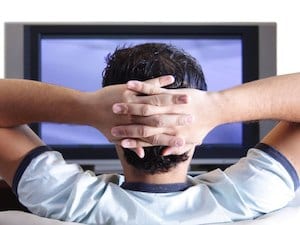
THURSDAY, Feb. 22, 2018 (HealthDay News) — Hours spent binge-watching that hot new series might feel great, but it’s doing no favors for your blood vessels, new research shows.
The study found that people who spend too much time in front of the TV are at increased risk for blood clots in their veins — a condition called venous thromboembolism (VTE).
These clots, which often occur in the legs, can dislodge and travel to the lungs, causing a potentially deadly condition called pulmonary embolism.
The clots have also been nicknamed “economy-class syndrome,” after cases occurred among passengers on long-haul flights.
As the University of Minnesota researchers explained, sitting for long periods of time can cause blood clots to form, because normal circulation through the legs and feet is impaired.
So, could prolonged TV viewing raise the risk? To find out, the researchers analyzed data from more than 15,000 Americans, aged 45 to 64, in a long-term study that began in 1987.
As of 2011, nearly 700 cases of VTE had occurred among the participants.
Those who watched a lot of television had a 70 percent higher risk of developing one of the clots than people who never or seldom watched TV. This risk remained high even after factors such as the person’s weight or exercise levels were taken into account.
The research was published online Feb. 21 in the Journal of Thrombosis and Thrombolysis.
The study couldn’t prove that it was the TV watching, specifically, that caused the uptick in clots, it could only point to an association.
Still, “even individuals who regularly engage in physical activity should not ignore the potential harms of prolonged sedentary behaviors such as TV viewing,” lead author Yasuhiko Kubota, of the University of Minnesota, said in a journal news release.
Two heart specialists unconnected to the study agreed that “couch potato” lifestyles can certainly impact health.
Dr. Maja Zaric is an interventional cardiologist at Lenox Hill Hospital in New York City. She said there’s “undoubtedly” a connection between time spent watching TV and a person’s odds for blood clots, but she wished the research had been more specific about just how much TV time was involved.
Zaric pointed out that participants simply estimated their TV viewing time as “never or seldom,” “sometimes,” “often” or “very often” — and those assessments could be very subjective.
“It would be interesting to see how much actual time in hours was there in each category,” Zaric said. “There may be a different view on the amount of TV watching between an obese subject with advanced arthritis and chronic back pain and a fit subject at healthy weight.”
Dr. David Friedman is chief of heart failure services at Northwell Health’s Long Island Jewish Valley Stream Hospital, in Valley Stream, N.Y. He said, “this is another study indicating the need for people to be more physically active and fit, move more, and keep weight in check — and probably watch less TV.”
Friedman suggested that as people become more mobile and watch television on their smart devices, “they could improve aerobic physical fitness and watch their favorite TV programs on the go as a way to help mitigate this effect.”
More information
The American Heart Association has more on venous thromboembolism.
